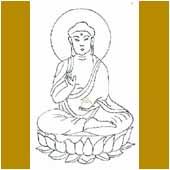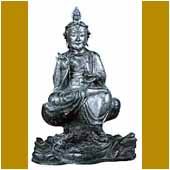
Shakyamuni
Bhaishaguru
Maitreya
Akshobya

Identity
Shakyamuni, 'sage of the Shakyas', founder of Buddhism, is often referred to
simply as the Buddha or the Historical Buddha, although many Buddhists believe
that more than one Buddha, or 'enlightened one', has existed in this world.
Born in Lumbini (in modern Nepal) in the sixth century BC as Prince Siddhartha
Gautama of the Shakya clan, he rejected his royal lifestyle in order to pursue
a true understanding of the nature of life. He followed several spiritual leaders,
some of whom practised harsh austerities including starvation, but was unsatisfied
by their teachings. After years of searching, he achieved spiritual enlightenment,
nirvana, after meditating intensely under a pipal tree. From then on, he became
known as Shakyamuni or the Buddha.
The Buddha then travelled around India sharing his knowledge until his death,
and final enlightenment, or parinirvana, at the age of about eighty. His teachings,
or dharma, also known as the Middle Way, emphasize a life of moderation based
on the Four Noble Truths: (I) life is full of suffering; (2) the source of suffering
is desire or attachment; (3) to end suffering, we must transcend desire and
attachment; (4) to do so, we must follow the Eightfold Path of right speech,
right livelihood, right action, right effort, right mindfulness, right concentration,
right opinion and right intention.
Representations and Attributes
For the first six hundred or so years after his death, the Buddha and his teachings
were represented in art by images of the wheel (of the law), footprints, empty
thrones, and other symbols of his teachings or his holy presence. Around the
first century AD, images of the Buddha began to appear in northen India, depicting
the Buddha wearing monk's robes and a serene facial expression. His hands sometimes
cradle a monk's begging bowl. He is often shown standing or seated in the lotus
position, one hand usually gesturing fearlessness.
Many images of the Historical Buddha refer to five key moments in his life:
his birth; his departure from home: his attainment of enlightenment; his first
sermon; his death. These are represented in the Buddhist imagery of most Buddhist
cultures.
Bayshaguru

Identity
Bhaishajyaguru, the 'Healing Teacher', is one of the most popular forms of the
Buddha and is often known as the Medicine Buddha. While still a bodhisattva,
Bhaishajyaguru is said to have made twelve vows, some concerning the healing
of the sick. Consequently, as a Buddha, he has the specific task of dispensing
spiritual medicine to devotees. He is believed by many to have the power to
heal physical ailments also. In some Buddhist texts, Bhaishajyaguru was said
to be one of Eight Medicine Buddhas, who created medicinal plants and presided
over the seven worlds. In the Bhaishajyaguru Sutra, written sometime before
the sixth century AD, this Buddha is described as more than a spiritual and
physical healer. He is a supreme and cosmic Buddha who illuminates the entire
universe.
From Central Asia to Japan, he was believed to command a group of twelve warriors,
each representing one of his vows, or the twelve months. These fierce warriors
deefend the health of the faithful in Bhaishajyaguru's name. Just as Amitabha
presides over the Western Paradise, Bhaishajyaguru presides over the Vaidurya-prabhasa,
the Lapis Lazuli, or Beryl, Paradise in the East. In certain Chinese Buddhist
texts, Bhaishajyaguru is said to welcome those who dream of him at their death
into his Paradise.
Representations and Attributes
Bhaishajyaguru, like Shakyammuni, is usually shown as a seated Buddha wearing
monk's robes and holding a small medicine jar that represents his healing powers.
In Tibet, he is sometimes depicted seated in his Lapis Lazuli Paradise, and
in paintings he is generally coloured blue. He is usually shown with his right
hand in the gift-giving mudra, and in his left is a medicine bowl or a myrobalan
fruit, a five-sided lemon-like friut with medicinal properties found in India
and other tropical countries. In Japan, Bhaishajyaguru, or Yakushi, is often
depicted flanked by two bodhisattvas, Suryaprabha (Japanese: Nikko, 'Splendour
of the Sun') and Chandraprabha (Japanese: Gakko, 'Splendour of the Moon') in
a representation known as the Bhaisajyaguru Triad, or Yakushi Sanzon. In some
images of Bhaishajyaguru, the Healing Buddha is shown with seven small Buddhas
on his aureole, a reference to the other seven Medicinal Buddhas.

Identity
Maitreya, 'benevolence, friendship', is a unique figure in Buddhism as he is
both a Buddha and a bodhisattva. He is believed to be the Buddha of the Future,
successor of Shakyammuni, and is currently a bodhisattva waiting in the Tushita
Heaven, where future Buddhas dwell, for the right time to appear as Buddha in
this world. According to some Buddhist traditions, the period of the Buddhist
Law is divided into three main stages: (I) The Turning of the Wheel of the Law
(500 years); (2) The Deterioration of the Law (1,000 years); (3) The End of
the Law (3,000 years), during which Buddhism is no longer practise. After this
time Maiteya will appear in this world as a saviour figure and be enthroned
by Shakyamuni as the next Buddha. His future status as a Buddha earns him the
title 'Maitreya Buddha'.
Representations and Attributes
Since Maitreya is Buddha of the Future, he is usually depicted as a bodhisattva
wearing a crown and jewelry, indicating his current attachment to the world.
In early images from Gandhara (inmodern Pakistan, Afghanistan and northwestern
India), Maitreya wears a robe resembling a Roman toga, and stands or sits regally
with one hand in the fearlessness gesture. In some Chinese, Southeast Asian,
and other images, Maitreya sits on a throne with one or both legs pendant. In
early Gandharan as well as East Asian sculptures, Maitreya sits with his right
leg crossing over his left, his right hand touching his cheek and the elbow
resting on his knee in a contemplative pose that suggests his presence in the
Tushita Heaven waiting to appear as the Buddha. In some of these images, he
is shown with one of his principal attributes, a small stupa in his headdress.
In Himalayan images, Maitreya is an elegant bodhisattva, crowned and bejewelled
and seated in the lotus posture. He often wears a scarf around his waist, and
and antelope skin over his left shoulder.

Identity
Akshobhya, 'the Imperturbable', is the second of the five Dhyani Buddhas, and
represents the element air. This Buddha is said to have expressed a wish never
to experience strong emotions such as anger or repulsion and to remain undisturbed
in order to achieve any task he set himself. He corresponds very closely to
the Historical Buddha, Siddhartha Gautama, at the moment of enlightenment, when
he called the earth to witness that he was unperturbed by the distractions sent
by the evil King Mara. Akshobhya is believed to inhabit the Eastern Paradise
of Abhiriti, as Opposed to Amitabha's Western Paradisc. This belief has led
to his being replaced in some Buddhist traditions by Bhaishajyaguru, who also
resides in an Eastern Paradisc.